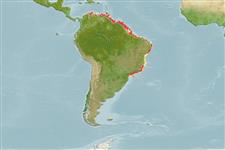Teleostei (teleosts) >
Eupercaria/misc (Various families in series Eupercaria) >
Sciaenidae (Drums or croakers)
Etymology: Cynoscion: Greek, kyon = dog + Greek, odous = teeth + Greek, skion, skiaina = barbel, red mullet (Ref. 45335).
More on author: Cuvier.
Environment: milieu / climate zone / depth range / distribution range
Ecology
Marine; brackish; demersal; depth range ? - 30 m (Ref. 3702). Tropical; 15°N - 29°S, 78°W - 34°W
Western Atlantic: Venezuela to Santos, Brazil.
Length at first maturity / Size / Weight / Age
Maturity: Lm 32.1 range ? - ? cm
Max length : 92.0 cm TL male/unsexed; (Ref. 3702); 78.0 cm TL (female); common length : 50.0 cm TL male/unsexed; (Ref. 3702); max. published weight: 3.0 kg (Ref. 5217)
Dorsal spines (total): 11; Dorsal soft rays (total): 22 - 25; Anal spines: 2; Anal soft rays: 8 - 10. Silvery greenish to greyish on back, whitish on belly. Tip of dorsal fin darkish. Upper rays of pectoral fins, anterior part of anal fin and caudal fin yellowish. Mouth large, oblique, lower jaw projecting. Upper jaw with a pair of large canine-like teeth at tip. Gradually increasing in size posteriorly. Chin without barbel or pore, snout with 2 marginal pores. Gas bladder with a pair of long and straight horn-like appendages. Scales very small, all cycloid (smooth) with 140 or more transverse scales above lateral line. Soft portion of dorsal fin covered with scales beyond basal half of fin (Ref 51721).
Usually found over mud and sandy bottoms in river estuaries and in marine areas from the coastline to about 30 m depth. Marketed mostly fresh.
Life cycle and mating behavior
Maturity | Reproduction | Spawning | Eggs | Fecundity | Larvae
Chao, L.N., 1978. Sciaenidae. In W. Fischer (ed.) FAO species identification sheets for fishery purposes. West Atlantic (Fishing Area 31). Volume 4. FAO, Rome. (Ref. 3702)
IUCN Red List Status (Ref. 130435: Version 2024-1)
Threat to humans
Harmless
Human uses
Fisheries: commercial
Tools
Special reports
Download XML
Internet sources
Estimates based on models
Preferred temperature (Ref.
123201): 24.1 - 28, mean 27.5 °C (based on 306 cells).
Phylogenetic diversity index (Ref.
82804): PD
50 = 0.5000 [Uniqueness, from 0.5 = low to 2.0 = high].
Bayesian length-weight: a=0.00724 (0.00481 - 0.01091), b=3.07 (2.95 - 3.19), in cm total length, based on LWR estimates for this species & Genus-body shape (Ref.
93245).
Trophic level (Ref.
69278): 4.0 ±0.7 se; based on size and trophs of closest relatives
Generation time: 7.3 ( na - na) years. Estimated as median ln(3)/K based on 1
growth studies.
Resilience (Ref.
120179): Low, minimum population doubling time 4.5 - 14 years (Preliminary K or Fecundity.).
Fishing Vulnerability (Ref.
59153): High vulnerability (57 of 100).
